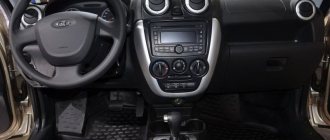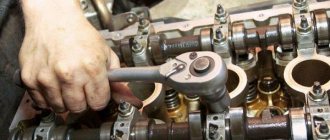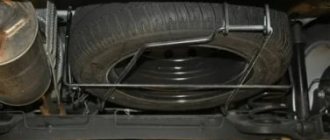If the image doesn’t bother you, you like the ground clearance, like a jeep, and in addition, you’ll admire the large capacity in the form of a 5/7-seater interior and a huge trunk, and “not expensive” - that’s all, we’ve arrived. Yes, not on anything, but on a raised Lada Largus with a talking Cross prefix and, of course, DNA from Renault Logan. This model, first presented to Russians in 2015, does not have many competitors. Of the serious ones, we can only remember the Lada Kalina Cross (in-brand cannibalism, as they say), and of the not very serious ones - the Renault Sandero Stepway, which seems small compared to the Lada station wagons, and the “Chinese” like the Lifan X50/X60 or the Geely MK Cross, whose reputation , alas, cannot boast of impeccability. Read all the details about the cross-version, which was begging to be released after the standard Largus with its modest ground clearance, in our review!
Design
Design
While working on the chassis settings, Lada engineers were equally concerned about handling and the quality of driving comfort. The stretched budget B0 chassis from Renault Logan (wheelbase is as much as 2,905 m) provides the Largus Cross with excellent directional stability. The station wagon clearly moves along a given trajectory on a high-speed straight line and on turns, and it is extremely difficult to knock it off the intended path. The smooth ride of the cross-version is slightly worse than that of the regular Largus: the suspension transmits “small things” into the cabin, but it perfectly absorbs large irregularities. For broken roads, this is undoubtedly a worthy option.
Adaptation to Russian conditions
The Largus Cross does not have an all-wheel drive transmission or simulated cross-wheel locking with the ESC system, but it can be driven on light and dry off-road conditions, since the model has good cross-country ability. An additional insurance when driving on deep ruts or a snowy yard is a plastic body kit. For trips to the country or fishing, you can’t think of a better option for similar money. In order not to freeze in winter, the car is equipped with heated front seats and side mirrors. And to create optimal conditions in the summer, there is air conditioning, and in absolutely all trim levels. Unfortunately, heated steering wheel and windshield are not allowed.
Comfort
Safety
The standard equipment of Largus Cross, unlike Largus, includes not one, but two airbags - for the driver and front passenger. You won’t have to pay extra for other pillows - they are simply not provided here. The “base” also has Isofix mounts for child seats, anti-lock braking system (ABS), brake force distribution (EBD) and engine crankcase protection made of 2 mm thick steel. Available options include: an emergency button to call emergency services in case of an Era-Glonass accident and rear parking sensors. By default, the car is equipped with reinforced front suspension arms and the largest possible brakes. The body has special anti-corrosion and anti-gravel protection.
Multimedia
Regardless of the configuration, the Largus Cross center console is equipped with an ordinary audio system with support for MP3, radio, AUX and USB inputs for connecting gadgets, Bluetooth and the Handsfree function, which allows you to answer phone calls without interrupting the ride. There is no talk of any features like compatibility with iPhones, voice control or navigation. We haven't forgotten about Bluetooth, thanks for that. The sound from 4 speakers is such that you can live with it, but I would like to live with something better. However, you need to understand that you shouldn’t expect anything outstanding from a budget device built on the “cheap and cheerful” principle.
Lada Largus Cross 5 Technical characteristics
Under the hood of the raised Largus is a 1.6-liter 16-valve “four” from Renault Logan, which does not disdain 92-octane gasoline. The engine develops 106 hp. at 5800 rpm and 148 Nm at 4200 rpm, works in tandem with a non-alternative 5-speed manual transmission and, judging by the passport, consumes an average of up to 9 liters. per 100 km. This combination of units is ideal for the Logan-like Largus Cross. In terms of its parameters, the 16-valve engine is in many ways similar to a diesel engine, which has a characteristic juicy thrust in the lower crankshaft speed range. At the same time, the gasoline unit is quite flexible: in traffic jams, nothing prevents you from driving in 2nd or even 3rd gear, and the engine output is quite enough for dynamic acceleration on the highway. The downside of these settings is an increased fuel “appetite” at highway speeds, which is associated with the operation of the 5-speed manual transmission with short gears. The smoothness and accuracy of the gearbox shifts do not raise any questions, but the 6th gear is clearly not enough for complete happiness.
Specifications
| Characteristic | 1.6MT |
| Engine's type: | Petrol |
| Engine capacity: | 1598 |
| Power: | 106 hp |
| Acceleration to 100 km/h: | 13.1 s |
| Maximum speed: | 165 km/h |
| Consumption in the urban cycle: | 11.5/100km |
| Extra-urban consumption: | 9.5/100km |
| Combined cycle consumption: | 9.0/100km |
| Fuel tank capacity: | 50 l |
| Length: | 4470 mm |
| Width: | 1756 mm |
| Height: | 1682 mm |
| Wheelbase: | 2905 mm |
| Clearance: | 170 mm |
| Weight: | 1270 kg |
| Trunk volume: | 560 l |
| Transmission: | Mechanical |
| Drive unit: | Front |
| Front suspension: | Independent – McPherson |
| Rear suspension: | Semi-independent – torsion beam |
| Front brakes: | Disk |
| Rear brakes: | Drums |
| Production: | Tolyatti |
Dimensions Lada Largus cross 5 seats
- length - 4.470 m;
- width - 1.756 m;
- height - 1.682 m;
- wheelbase - 2.9 m;
- ground clearance - 170 mm;
- trunk volume - 560 l.
Results
As you can see, the Lada Largus Cross differs in some respects from the Lada Largus. Knowing these differences will make it easier for you to make your choice.
Lada Largus Cross is a modern domestic car, preferred by Russian car enthusiasts for the following reasons:
- acceptable price;
- technical and driving characteristics adapted to our roads;
- decent appearance;
- good efficiency indicators with fairly impressive dimensions.
Main technical characteristics:
- There is only one engine version, a 1.6 liter four-cylinder engine with 105 hp. With.
- Five-speed manual transmission.
- The car consumes nine liters of gasoline per 100 km.
- The car can accelerate to 165 km/h.
Naturally, the Russian pseudo-crossover has its pros and cons, but a more objective opinion can be formed from real reviews of car owners.
Test drive Lada Largus cross 5 seats – video
Advantages and disadvantages of Lada Largus cross 5 seats
You will like Largus Cross if you value:
The advantages include:
- affordable price;
- good maneuverability;
- spacious interior;
- spacious cargo compartment;
- unpretentiousness to the quality of gasoline;
- good equipment.
The disadvantages include:
- boring design;
- budget-friendly interior decoration;
- ergonomic shortcomings;
- mediocre dynamics;
- There is no heated steering wheel or windshield.
LADA Largus Cross – the long-awaited continuation of the station wagon
What kind of person would refuse to relax in nature? This car is for those who like to quickly be at the dacha or on a picnic, while actively using the car. The crossover is distinguished from the station wagon by its brighter exterior design, the presence of plastic linings on the bumpers, sills and wheel arches, film-covered door frames, and larger tire sizes. The interior is also multifunctional, like a station wagon, but aesthetically more original and bright. The use of orange leather inserts in the shoulder area and seam trim of the same color adorn all seats. Continuing the color theme is the center console trim and door trim inserts in the same orange color. The interior is somewhat aggressive, but interesting. There are heated seats and air conditioning. And the interior is completed with a signature touch - the inscription “Largus Cross”.
- Cross is a car with the same spaciousness, with a reliable suspension and a high-torque engine.
- Cross is comfort and capacity.
- Cross is the best price in its class.
- Add to this the increase in ground clearance and we get the amazing cross-country ability of the Cross.
- Let's not forget about the safety of the Cross - two front airbags, an anti-lock braking system, additional safety bars, special seat mounts for children and seat belts.
Which is better Largus or Duster
Despite the similarity of these two cars, they are still noticeably different. After all, Duster is a car for conquering off-road conditions, while Largus is more of a universal car for all occasions. Yes, we can say that Renault’s brainchild is far from the ideal of the king of off-road, and the model from Lada is quite capable of coping not only with the road. But we are talking about the purpose and ability to regularly perform certain functions, and not about what the machine is capable of as an exception.
If you have a family and need a large, spacious car model, then you should think about Largus, since the capacity of the Duster is much lower. But if you still need a car for trips, for example, fishing, then of course, Lada is not a competitor for Renault.
It turns out that both cars have positive properties, but they are fundamentally different in their purpose. However, this aspect is not the only one that should be taken into account when choosing the appropriate option.
To understand whether a Lada Largus or Renault Duster is more suitable, you should pay attention to their characteristic features inside and outside, as well as the technical characteristics of these models.
Ground clearance Lada Largus 5 and 7 seats. How to increase ground clearance?
Ground clearance is the distance from the surface of the earth to the lowest point of the car. It’s no secret that the higher the ground clearance, which is also the ground clearance, the more passable the car. So what is the ground clearance of the Lada Largus? According to official data, the ground clearance of the Lada Largus is 145 mm. Is it a lot or a little? We'll talk about this further.
Interior and exterior
The cars are seriously different both inside and outside. This will not be clear to everyone at first glance, but if a person is close to cars, he will soon notice the difference. Both the interior and the exterior are important components of the car, because both of them have an aesthetic function, while the design of the cabin seriously affects the level of comfort.
From the inside
A very important point is the view from the inside. In Duster it is slightly smaller in the front, but larger in the back. This is due to the fact that the Largus has a sloping hood at the front, while the already limited rear visibility can be hampered by the rear seats if they are folded down.
In addition, Largus has a problem with the side windows, which have a small area. This is due to the fact that the door frame significantly blocks the view. Moreover, some areas of glass cannot be cleaned at all, which, of course, will not please people with a sophisticated aesthetic perception.
As for the seats, Largus is definitely the leader here, because they are much softer and more comfortable. Duster is no different in terms of comfort in this regard. And this circumstance is definitely a disadvantage for the model from Renault, since the softness of the seats is especially important for an SUV.
But the advantages of Duster include the fact that the dashboard is made of normal plastic. As for Largus, its various switches are, frankly speaking, “wooden”, which affects the level of comfort no less than the comfort of the seats.
So which car has a more relaxed interior? Perhaps it all depends on personal preferences. However, if we talk about the passenger, then he will definitely be more comfortable in Largus. If the priority is a soft seat, then the Lada will do, and if you want a relatively pleasant dashboard at hand, you should think about the Renault. And the most important thing to consider is which review will be more convenient.
Outside
What about the exterior? Oh, it's mostly a matter of taste. But first, it’s worth considering some practical features. Largus at first glance suggests that this machine is for universal use, and not for conquering off-road spaces. Duster's ground clearance is higher, although only slightly. However, even this difference can play a significant role outside the road surface.
As for the dimensions, they, in general, also speak of Largus as a car, not for off-road use, but for daily use in different situations. The car is much more massive. It has a higher roof and a wider trunk. The car is large, which in itself is not a hindrance off-road, but the Lada does not have the necessary power and the typical shape for an SUV, because it is too long. If you look at the model briefly, it can even pass for a minivan.
Let's clarify for the cross-variant
Prudent specialists from AvtoVAZ managed to turn ordinary Logan station wagons into crossovers. They modified some of the suspension components and replaced the rear springs. I also had to change the tire size. If it was 185x65R15, now we have 205x55xR16.
All these simple transformations made it possible to increase the ground clearance by as much as 25 mm.
Finally, we present the ground clearance, or rather its size, for this modification in different states:
- subject to maximum loading - 170 mm;
- without the presence of the fact of loading - over 180 mm.
When standard modifications of tires with rims are used (meaning “R15”), the ground clearance of the Lada Largus Cross tends to drop by as much as 5 mm. Let us emphasize the wheel diameters in the standard and “cross” variations: 621.5 and 631.9 mm, respectively.
In conclusion, we note that the Cross lags behind the Duster, whose ground clearance reaches 200 mm, by some 20 mm.
Video where clearance measurements are taken in various passenger cars, including in Largus:
Engines
As for motors, the differences with them are significant. The models are similar in that their engine capacity has few cubic meters. Plus it's about the same. The difference is only a couple of cubic centimeters. Approximately, the volume is 1.6 liters, which is not that much, but taking into account the budget, it is quite expected and acceptable.
But in terms of power, the Duster is significantly superior to its competitor, because it is capable of demonstrating all 114 horsepower at the peak of its capabilities. Is this too much? No, and again no, and to be convinced of this, just look at the characteristics of the top representatives of the SUV or station wagon class, where even 300 horsepower is by no means the limit.
That is why the fact that the Lada has only 87 horsepower makes the Duster much more interesting for those who are interested in dynamic performance rather than some other features of the car. In this case, the difference of almost 30 horsepower will play a significant role in how these two vehicles perform on the road.
As for the torque, the Renault Duster has 156 Newtons per meter at 4000 rpm, while the Lada has only 140 Newtons per meter at 3800 rpm, which, however, is also not bad. It turns out that the engines of the cars, although they are not too different, the Duster version is still more suitable for off-road driving, while the Largus Cross is unlikely to cope with a really serious cross-country race.
Model appearance
The presentation of the Lada Largus Cross was quite loud, a lot of good things were said about this car, but after the test drive the public was a little disappointed and there are many reasons for this.
It was revealed that all modifications to the body consisted of the appearance of black plastic linings that were installed on the bumpers, and the same plastic wheel arches and sills. And this plastic cannot give the car off-road potential. Of all the body upgrades, the most significant is considered to be the increased ground clearance of the Lada Largus, which has now become 170 mm. The suspension has also been slightly changed, it has become adapted for off-road driving. But serious off-roading is beyond the capabilities of this car, and for a trip to the country it’s just the thing.
Recommended article: Koreans have announced a new price list for the Russian version of the SsangYong Actyon
The appearance is decorated with new standard 16-inch alloy wheels with oversized tires. It is worth noting that AvtoVAZ developers called the plastic elements used “aggressive design.” This is their subjective opinion, because what exactly the aggression is is not clear, and the developers did not explain anything, plastic is like plastic, especially since it does not have any special properties.
But in general, the Lada Largus Cross (photo below) is very similar to the French-Romanian Dacia Logan MCV 2006, the only difference is that the Lada Largus Cross has a different radiator grille and bumper. The body shape is quite angular, and the large rear part of the car, where the vertical pillars and tailgates are located, make this car very similar to a minibus, which is good enough for commercial purposes - transporting potatoes, for example.
Also, this car has quite simple head optics, a flat roof, which is also nothing special. Mirrors and door handles also do not differ in any originality. Therefore, looking at all these details, it becomes clear that the Lada Largus is not a particularly elegant car. But there is nothing wrong with that, because elegance is not at all necessary for an SUV.
You can even remember Gelendvagen, everything there is also not so elegant, but its off-road qualities are excellent. Likewise, the Lada Largus Cross has this roughness, so it can even be considered an advantage, after all, this is an off-road model. The gaps between the wings and the hood are also noticeable, and they are quite large, and this does not look aesthetically pleasing at all.
Comparison of versions
The car has only three trim levels: Standard, Norma, Luxe. But these trim levels, with the exception of the very first, come in addition to three packages: Climat, Comfort, Prestige. The simplest Standard package is equipped with safety systems: ABS and EBD, these systems are supported by a driver airbag, Isofix child seat mounts, and the Era-Glonass emergency warning system (more recently, this system is required for installation on all cars that drive on the territory of the Russian Federation), child locks of the rear doors (allow you to block the interior door handles when the outside ones are active).
Among the functions that increase comfort and ease of control, there is a steering wheel height adjustment, a 12-volt power socket, a cabin air filter, audio preparation, roof rails and a full-fledged spare wheel. There is no add-on package available for this configuration. The second version on the list is Norma, which adds to the list of equipment, including power steering, a 60:40 folding rear seat, central locking, and front electric windows. The appearance is complemented by moldings around the perimeter of the body and bumpers in body color. There are also two option packages to choose from. The first is a simpler Climat package, it includes heated front seats and air conditioning, the second is a slightly richer Comfort package, it adds a shelf in the ceiling above the luggage compartment, and a floor covering the trunk, an audio system with two speakers (supports Bluetooth protocol, and also has USB and AUX ports).
Equipment
In all respects, with the exception of ground clearance, the cars are absolutely identical. This model, regardless of what brand it is produced under, was designed on the B0 platform. Dimensions are equal to L-W-H: 4470-1750-1670 mm. The ground clearance varies for the regular version: 175 mm when unloaded, 150 mm when loaded; for the Cross version the ground clearance is 195 mm. The trunk volume is also very variable, from 135 liters in the seven-seater version with the seats folded down. Then 560 in a five-seater, and 2350 liters, although only with two seats. The fuel tank volume for gasoline versions is 50 liters and the gas tank volume is 90 liters for CNG versions.
The range of engines is represented by both Renault and AvtoVAZ engines. The weakest in the range is the French-developed inline four, factory code K7M. The volume of this engine, like other Largus engines, is 1.6 liters. Power is around 82 horsepower at 5500 rpm and torque of about 124 Newton meters. Fuel consumption in the combined cycle is 9.3 liters, in the city 12.3, on the highway 7.5.
The second most powerful engine is a Russian one with the same volume and number of cylinders. The VAZ engine code is 11189, essentially the same K7M, only with slightly different attachments and modified engine mounts. Its power has increased to 87 horsepower, and torque to 140 Newton meters.
The third engine is the 1.6 installed on Megan and Logan with sixteen valves and a power of 102 horsepower at 5750 rpm and 148 Newton meters at 3750 rpm. The code for this motor is K4M. Fuel consumption: about 9 liters in the city and 7 on the highway.
The fourth power plant is the VAZ-21129, essentially the same engine as was installed on the Priora, only it complies with Euro-6 emission standards. Power is 106 horsepower at 5800 rpm, torque is 148 Nm at 4200 rpm. The consumption of such an engine in the city is about 11 liters, on the highway 6.4. In the combined cycle, consumption fluctuates between 7-8 liters per hundred. The chassis is presented with an independent McPherson-type suspension with anti-roll bar at the front. At the rear there is a U-shaped beam with programmable deformation zones. The brakes are disc at the front, drum at the rear. Steering mechanism, rack and pinion, at extra cost or in more expensive trim levels with power steering.
Powertrain and gearbox
Lada Largus Cross is equipped with a 4-cylinder engine running on gasoline, its volume is 1.6 liters. The power of this engine is 105 horsepower at 3750 rpm. The torque of this car is 148 Nm and is achieved at the same speed.
A 5-speed manual gearbox works in tandem with this engine. The car can accelerate to 165 km/h, and the car reaches the first 100 km/h in 13 seconds. Not particularly fast dynamic performance, and fuel consumption is also not low enough and amounts to 12 liters per 100 km in the city, on the highway consumption is 7.5 liters per hundred.
But if you compare the Lada Largus Cross with a regular station wagon, you can see that the suspension has been slightly improved, the shock absorbers have been retuned, and the ground clearance has increased by 25 mm. In addition, the off-road version of Largus has special springs, silent blocks and strut supports. According to VAZ engineers, this car has become better to drive and the brakes have improved. The shock absorbers themselves as a whole have also undergone reconfiguration. According to AvtoVAZ engineers, the new product received adjusted steering and brake systems. The characteristics of the Lada Largus Cross correspond to the new Russian car.
As practice has shown, driving this car corresponds to the promises of the developers. The suspension of the Lada Largus Cross now has increased elasticity; even when falling into deep holes, the car behaves quite calmly. But, thanks to this rigidity, if the car is not loaded with people or cargo, then the comfort for the driver will decrease slightly, it will be a little harsh for him to drive on harsh Russian roads.
Recommended article: Ford Focus 2 suspension (front and rear) requires repair
The steering wheel turns quite well, the car is responsive to any movement of the steering wheel, and the Largus Cross can very clearly respond to driver actions, the car is able to hold the road very smoothly, so if desired, you can drive this car on rails and not be afraid to accelerate to a maximum of 165 km /h.
The car will not be able to negotiate turns at high speed due to its center of gravity. But since this car is not intended for racing and cruising, but for business, transporting goods and people, it does not need to take turns at high speed.
Thanks to the high ground clearance and plastic bumpers, the driver can now feel more confident and easily jump onto the curb if necessary. As for trips to the country, fishing or to the forest, you don’t have to be afraid of potholes and other irregularities; the ground clearance allows you to feel confident in the countryside.
As for real off-road conditions, Largus has little chance here, so it’s better not to leave the dirt road, but in general you need to look at the situation; it happens that even serious SUVs get stuck in swamps.
When VAZ decides to produce these cars with all-wheel drive, then perhaps the Lada Largus Cross will be able to show something off-road, but for now it’s just a city crossover.
Visual differences
The appearance of the car, in fact, is no different from the appearance of the twins. There are differences in the front part; the VAZ model has a radiator grille and inserts for fog lights. After these upgrades, the car remains just as attractive, but now the front end looks much friendlier than the rest. The car has a very elongated profile; roof rails along the entire length of the roof add even greater visual length. And unlike other similar models, the car has very thick moldings around the perimeter of the body. The Cross version has the most attractive appearance, its off-road plastic body kit emphasizes the high ground clearance, and alloy wheels confirm Henry Ford’s famous phrase that wheels are 80% of a car’s appearance. In profile, the glass frames have dark staining, and from a distance one gets the impression that there are no gaps between them and the glazing is continuous. A very practical solution was to encase the sills and arches in plastic trims, this is also attractive, and also looks reminiscent of cars like old all-wheel drive station wagons such as the Outback or XC70.
Changes have also appeared inside, but they are just as insignificant. They mainly affected the center console and instrument panel. The ergonomics remain very thoughtful and comfortable, despite its simplicity. New buttons for power windows and hazard warning lights have appeared on the center console. The control unit for the stove or air conditioner remains the same. New speedometer and tachometer scales have appeared on the instrument panel, the arrows of which are no longer transparent. Between the instruments there is an on-board computer and a display with warning lights. In expensive trim levels, cars may have white dials or silver plastic edging that imitates metal.
Interior design and its features
When you drive a Lada Largus Cross, if you have previously driven a regular Largus, you immediately notice that there have been no significant changes in the interior. The driver's seat is quite comfortable and reliable; it can support a person of almost any size.
What’s also good about the cabin is that this car has adjustable lumbar support on the driver’s seat and a vertical steering wheel adjustment, which is also very convenient; you can adjust the seat and steering wheel to your liking. Also, the Lada Largus Cross has a fairly high seating position, so this car has good visibility, despite the body pillars. As for the front panel, it remains in the classic Largus form.
The interior design of the off-road version of the Cross also has some features, such as orange leather inserts on the front seats. The stitching and checkered patterns on the seats are the same color; they are a kind of decoration for all the seats. In addition, orange leather inserts are used on both the center console and the doors. This design move made it possible to diversify the Largus salon, without any significant costs.
Recommended article: Tuning UAZ Patriot will make the car better and more original
The interior of the Largus Cross version is quite spacious, 7 people can easily fit in it; AvtoVAZ has seriously worked on capacity, so there is enough space both in height and width. On the second row, 3 people can easily fit, and they will not interfere with each other, and their legs will not even touch the front seats. It is possible to install additional seats in the third row, this will allow you to create 2 more seats for passengers of absolutely any configuration. Since the seats in the 3rd row are located above the rear axle, passengers will experience all the bumps in the road and will shake a little.
Like almost any car, the Largus Cross can easily be converted into a very spacious truck by folding the rear seats; after this metamorphosis, the 200-liter trunk will turn into a huge 2500-liter trunk, which can accommodate a lot of cargo. The interior can be transformed quite easily and quickly; in addition, it is convenient to load and unload in this car thanks to doors with locks.
Summing up
This model is one of the most affordable offerings on the market, both commercial and civilian station wagons. The car has a large number of variations, ranging from a regular station wagon to a Cross version, which significantly expands its audience coverage. Its popularity is due not only to its wide range, but also to its reliability, which has been confirmed by years of operation of units and vehicles in various climatic and road conditions. These are not sweeping words, this has been proven by many summer residents, taxi drivers and representatives of small businesses. Its closest competitors are about a third more expensive, and for the same money they offer about the same thing. It would be very interesting if the Cross version received the Lada Ride Select system and electronic differential lock. Most likely, this version would gain popularity among people living far from standard roads, and who know what snowfalls or mud are like, certainly for a reasonable price.
“>
The reference point for ride height is the crankcase protection
The question is what exactly is considered the lowest point. For all passenger cars, for example, everything located near the hubs is excluded from consideration. Otherwise, we would have to count the ground clearance from the ball joint housings. You understand what value the result would have.
Under the bottom of Largus with a 16-valve internal combustion engine
The picture above shows what the bottom of a Largus car (van or station wagon) looks like. The engine here is protected by a metal insert. From it, that is, from the crankcase protection, the clearance is measured. The parts located below cannot be found on the bottom.
Passenger version ground clearance
Shown here is a car body with a K4M engine (16 valves). Ground clearance for this version is 145 mm. It will be no less if we talk about any 8-valve engine (K7M or VAZ-11189).
Van ground clearance
By the way, the ground clearance of the Lada Largus van is the same as that of the two passenger versions (145 mm).
Van ground clearance is 145 mm
And the value was measured this way: the car was fully loaded. There were 4 passengers and a driver in the cabin, and the trunk also did not go unnoticed. The 7-seater version added two more passengers. In general, everything was fair.
Photo of Lada Largus ground clearance in various places of the body
Fully loaded and standard curb weight – where did “155 mm” come from?
Studying the specifications of the Dacia Logan station wagon, you might be surprised: the ground clearance indicated in the documents is 155 mm! By the way, Logan MCV and Largus are the same model.
Dacia Logan MCV (station wagon)
The question remains which numbers should be trusted. And the answer is simple:
- AvtoVAZ carried out measurements at full load;
- Renault uses a different method - the body must be loaded to the “standard curb weight”.
Curb weight is the weight of the vehicle, as well as consumables and the driver. There is a small nuance here: if the documents indicate the tank volume as “40 liters”, but in reality it is 50, then they will fill it with exactly 40 liters of fuel. This technique is used by the Renault concern.
It turns out that if the cabin is designed for 7 or 5 seats, the ground clearance of the Lada Largus without loading will exceed 155 mm. The same applies to the van. Clearance can be increased.
Clarification for cross-version
The VAZ plant managed to make crossovers from ordinary Logan station wagons. The front suspension was modified, and the springs at the rear also had to be replaced. The tire size also changed: it was 185/65 R15, now it is 205/55 R16. As a result of all the changes, ground clearance has increased by 25 mm.
Here the clearance exceeds 180 mm
So, the value of ground clearance for the Largus Cross station wagon:
- Fully loaded – 170 mm;
- Without loading – more than 180 mm.
Let us remind you that the value is measured as the distance from the ground to the crankcase protection.
If you use tires and wheels of standard diameter (R15), the ground clearance of the Lada Largus Cross is reduced by 5 mm: 621.5 and 631.9 are the wheel diameters in the “regular” and “Cross” versions.
The typical value for the Duster crossover is “200 mm”, but it was measured using Renault’s method – a full load was not used. Largus Cross, therefore, “lags behind” Duster by only 20 mm or less.











